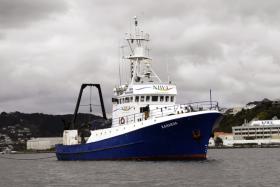Reports that snapper have been caught in waters around Fiordland and Dunedin have raised a few eyebrows, and the prospect that warming waters may be affecting fish distribution. We don’t know how environmental changes will affect spawning success or how many juveniles will eventually make it to adulthood in these changing environments. In an effort to estimate how many young snapper are in northern waters NIWA is conducting surveys this summer using their 30 metre research vessel Kaharoa.

NIWA’s first trawl survey was conducted in November in the Hauraki Gulf. The next survey will be in February in the Bay of Plenty, between the Mercury Islands and Cape Runaway, East Cape.
Recreational fishers need to be aware that NIWA’s research ship Kaharoa may be operating in areas not normally open to trawling. The vessel will be clearly marked with ‘RESEARCH’ banners so it will be easily identified, even from a distance.
This research is valuable as the numbers of juvenile snapper give a good indication of future recruitment, that is how many adult fish may be in the population and available to fishers in years to come.
Our largest snapper fishery is Snapper 1 (SNA1), which extends from North Cape to Cape Runaway on East Cape. In 2018 commercial fishers landed 4570 tonnes of snapper from SNA1. In the same year and area recreational fishers landed an estimated 3120 tonnes. Customary catch is unknown and unlikely to be large.
LegaSea supports NIWA’s efforts to gather data as there is a clear need to know more, especially as environmental conditions change.
There was a series of similar surveys in the 1990s to help make the link between warmer spring/summer water temperatures and increased spawning success for snapper. The connection was there, but not consistent enough to give a definitive answer. Using survey results to predict potential recruitment mostly helps with projections of future sustainable catch levels.
The past surveys also recorded details of all catch other than juveniles, including larger snapper and other species. While there is so much we do not know about fish and the interactions between species and their habitats, the time series of data over the years proved highly valuable. We lost that continuity when this research was halted 20 years ago.
The electronic reporting system aboard commercial vessels now will take time to bed in, and the commercial catch rates (CPUE) will not be useful in fisheries management assessments until there is four or five years of data available.
Recreational fishers have been calling for more fishery independent data on inshore fisheries for many years. Having data that is not reliant on commercial catch reporting, effort reporting and retention rates is most valuable because these aspects can be influenced by a range of factors that are not easily measured.
Moreover, trawl surveys are one of the only ways to get fishery independent data now that commercial fishing interests have actively withdrawn their support for the Snapper 1 tagging programme. The tagging study was one element of the Minister’s 2013 decision for SNA1 and was due to start in October 2014.
So, if you see the Kaharoa out on the water this summer give them a wave as we are now relying on the data from NIWA to better manage our valuable inshore fisheries.





